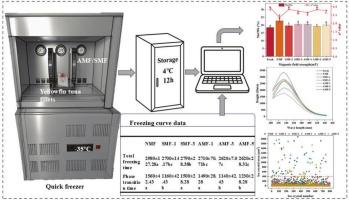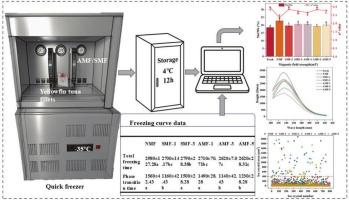辅助再冷冻过程中不同磁场条件对黄鳍金枪鱼微观结构和品质的影响
IF 9.8
1区 农林科学
Q1 CHEMISTRY, APPLIED
引用次数: 0
摘要
由于传统的冷冻方法会对鱼类造成严重且不可逆的损伤,为了提高黄鳍金枪鱼的冷冻品质,研究了磁场处理对黄鳍金枪鱼冷冻行为和肌肉品质的影响。在无磁场(NMF)、1和3 mT静磁场(SMF)以及1、3和5 mT交变磁场(AMF)六种条件下,与NMF相比,mf辅助冷冻显著缩短了相变时间,改善了物化性能、肌原纤维蛋白稳定性和冰晶形态。值得注意的是,SMF-1和AMF-3获得了最有利的结果,导致微观结构更紧凑,水分布均匀,冰晶更小,分布均匀。这些条件有效地保持了肌肉的完整性,减少了冰冻引起的损伤。总的来说,mf辅助冷冻,特别是在SMF-1和AMF-3下,显示出作为一种提高冷冻过程和保持鱼产品质量的新策略的潜力。本文章由计算机程序翻译,如有差异,请以英文原文为准。


Impact of varying magnetic field conditions on the microstructure and quality of yellowfin tuna during assisted re-freezing
As traditional freezing methods can cause serious and irreversible damage to fish, in order to improve the freezing quality of yellowfin tuna, the effects of magnetic field (MF) treatments on freezing behavior and muscle quality were investigated. Six conditions were applied: no magnetic field (NMF), static magnetic fields (SMF) at 1 and 3 mT, and alternating magnetic fields (AMF) at 1, 3, and 5 mT. Compared to NMF, MF-assisted freezing significantly reduced the phase transition time and improved physicochemical properties, myofibrillar protein stability, and ice crystal morphology. Notably, SMF-1 and AMF-3 yielded the most favorable results, leading to more compact microstructures, uniform water distribution, and smaller, evenly distributed ice crystals. These conditions effectively maintained muscle integrity and reduced freezing-induced damage. Overall, MF-assisted freezing, especially under SMF-1 and AMF-3, shows potential as a novel strategy to enhance the freezing process and preserve the quality of fish products.
求助全文
通过发布文献求助,成功后即可免费获取论文全文。
去求助
来源期刊

Food Chemistry
工程技术-食品科技
CiteScore
16.30
自引率
10.20%
发文量
3130
审稿时长
122 days
期刊介绍:
Food Chemistry publishes original research papers dealing with the advancement of the chemistry and biochemistry of foods or the analytical methods/ approach used. All papers should focus on the novelty of the research carried out.
 求助内容:
求助内容: 应助结果提醒方式:
应助结果提醒方式:


